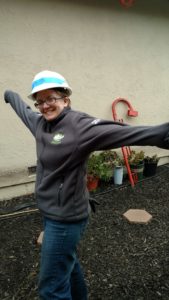June Great Story by Gilian Corral, Bay Area South Fellow
It’s 8:22 AM and the sky is cool and clear. I park my Prius across the street from the GRID Alternatives work site. I’d carefully selected my outfit the night before to maximize comfort and sun protection: jeans I’d be ok ruining, tennis shoes, light cotton long sleeved shirt, movie star-wide sunglasses. I also carefully selected my attitude. I have decided not to default to my Safe Zone approach: pick the job I know I can do best, with people I feel most familiar. Today, I am going to step boldly into solar unknown – whatever tool and job that’s offered to me, I’m going to take it, do my best, and learn.
Folks are unloading construction things from a small trailer with GRID Alternatives printed in friendly letters on the side, hitched to a pick-up truck. A woman with glasses is making conversation with one of the guys in a GRID tee shirt with the casual familiarity of someone who speaks construction.
“Who wants to get on the roof today?” Asks a guy in an orange shirt – he’s the volunteer Team Leader.
“Me!” I say quickly…step boldly, right?
“Ok, everyone on the roof, grab a safety harness.” He points us to a tub of straps and buckles, all jumbled together. I’m instantly transported to the moment I first picked up a baby wrap and feel a familiar stab of “stupid panic” – the fear of looking stupid trying to figure out what should be easy. Then I remember my attitude, that I selected this morning on purpose, and smile at the Orange Shirt man.
“How do you put one of these on?”
He starts to explain, then gets corrected by a blue shirt man. Well, maybe it’s not so easy after all. Blue Shirt, who’s a GRID staff member, walks me through the buckling and snapping, step by step.
At the top of the ladder, another blue shirt guy (Daniel) snaps a metal clamp to my back, connecting me to a “lifeline” strap. The asphalt shingle grinds under my tennis shoes. Daniel huddles the volunteers and unfolds the plans for the project, pointing out where the panels will go. Our crew is a mix of experience levels. I’m the only first-timer, but I don’t feel left out. Every step of the way, Daniel and the team leader explain what they’re doing, involving us in the measuring, calculations, and physical work. I get a power tool thrust in my hands and am told on the spot how to use it.
There are a lot of steps to remember in solar installation. I had this idea that you just slapped the rack up there and clicked in the panels…yeah, not so much. The process is an odd mix of calculation and gut feeling. Take finding rafters, for example: you can measure between rafters and estimate where the next one will be, but that’s often wrong. You drill a hole and feel if it hits something. If it’s a miss, you take this metal stick and feel around in the hole for the rafter. Daniel takes a hammer and kind of bangs around the roof tiles, listening for a solid noise that may or may not happen. Sometimes, Daniel just points, lines up the drill, and says, “It is here.” How does he know that? There’s no code for Rafter Location Clairvoyance on my skill list to check off, thank God.
By the end of the day, I feel so comfortable in the harness and hard hat, it feels weird to walk around without them. My knees are burning from kneeling on the now-hot tile, and the roof is starting to look like a solar project instead of a map of chalk lines. We’ve racked half the roof, leaving the other half for a team of Goldman Sacs volunteers to finish off tomorrow. Daniel hands me the impact driver and with a mechanized whir, I drive a bolt into a clamp and thus install my very first solar panel! I take a moment to admire it glinting in the sun, but just a moment, because another one is making its way up the roof.
Back home, scrubbing roof tar from my fingernails, I think about what it would be like to wear a hard hat all the time, to feel the drill under a confident palm and guide it through an invisible rafter with easy, graceful precision. To scan the roof of my 10th, or 100th solar installation and calculate parameters within the space without thinking.
In the mirror, a weary, sun-baked face looks back at me under a matted mess of helmet hair. Tomorrow I’ll go back to my Excel spreadsheets. But today, I was a solar installer.

